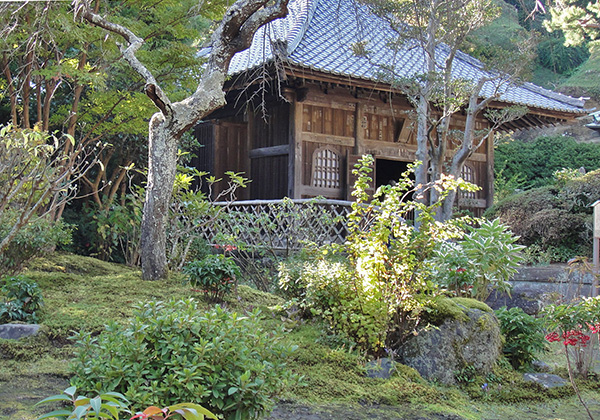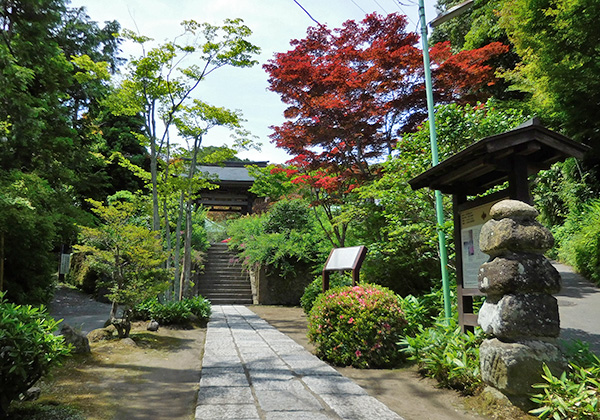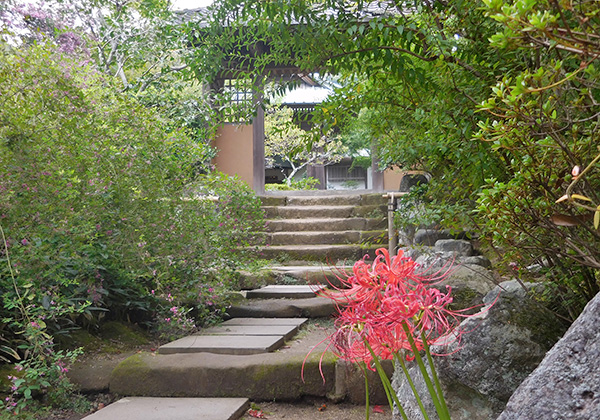Kaizoji
| Official Name | Senkoku-zan Kaizoji {Pronounced sen-kok-zan kye-zoh-gee} |
|---|---|
| Religious sect | Kenchoji School, Rinzai (Zen) Sect, Buddhism |
| Founded | in 1394 by Ujisada Uesugi {woo-gee-sah-dah woo-eh-soo-ghee} |
| Founding priest | Shinsho Kugai {shin-shoh koo-gye} |
| Main object of worship | Statue of Yakushi Nyorai or Bhaisajyaguru-vaiduryaprabha in Sanskrit |
| Address | 14-8 Ogigayatsu 4-chome, Kamakura, Kanagawa 248-0011 (show route from current location ) |
| Location | 1,300 meters north-northwest of Kamakura Station |
| Time needed to get there | 20 minutes |
| Admission | Sixteen Wells:JPY100 |
| Open | 9:30 - 16:00 |
| Phone number | 0467-22-3175 |
| Restrooms | Available |
Historical Overview
The Temple was built not in the Kamakura Period (1185-1333), but during the Muromachi Period (1336-1573). Kamakura was no longer the Capital of Japan. The founder was Ujisada Uesugi (1374-1416), then Vice Governor of Kamakura, and the Temple was built under the instruction of Ujimitsu Ashikaga {woo-gee-me-tsu ah-she-kah-gah} (1359-1398), the Second Governor of Kamakura. At the time, Japan was being ruled by the Ashikaga Shogunate in Kyoto. In Kamakura, the first son of Takauji Ashikaga (the founder of the Ashikaga Shogunate) assumed the governor's post, and thereafter, the office was held by the successive members of his family to control eastern Japan. Since governors were mostly young and titular, however, vice-governors were virtually at the helm. This vice governor's post also became hereditary in 1363 and was succeeded by the member of Uesugi families. Temple founder Ujisada Uesugi was among them.
Founding Priest Shinsho Kugai (1329-1400), a.k.a. Priest Gen'no, was reportedly a descendant of Priest Doryu Rankei (the founding priest of Kenchoji) in the fifth generation. In its golden days, the Temple had more than 10 structures, but today, there are only a few.
There is a Noh play entitled Sessho-seki or "A stone that kills animals", which originates from the legendary story of the founding priest. Once upon a time when Emperor Toba {toh-bah} (1103-1156) were ruling Japan, he was annoyed at one time by a mysterious disease. Soothsayers declared that his sickness was caused by a white fox, and the fox was a transformation of his daughter. The Emperor banished a white fox down to Tochigi Prefecture, and later ordered Yoshiaki Miura {yo-she-ah-key me-woo-rah} (1092-1180), a faithful retainer of Yoritomo Minamoto (1147-1199), the founder of the Kamakura Shogunate, to kill the fox. After the killing, the fox transformed into a stone. The stone was called Sessho-seki , since all animals that touched it died instantly. Hearing this story, the founding priest of the Temple came down to Tochigi to deal with the murderous stone. As he neared the Sessho-seki, he found a great deal of skeletons scattered around it. Chanting sutras with strong willpower, he struck a blow on the stone by a hammer. The stone was crushed with his one blow. The spirit of the stone departed in peace and thereafter no people or animals were killed.
Today, the hammers used by masons are called "Gen'no", which was named after Priest Gen'no, the posthumous name of the founding priest.
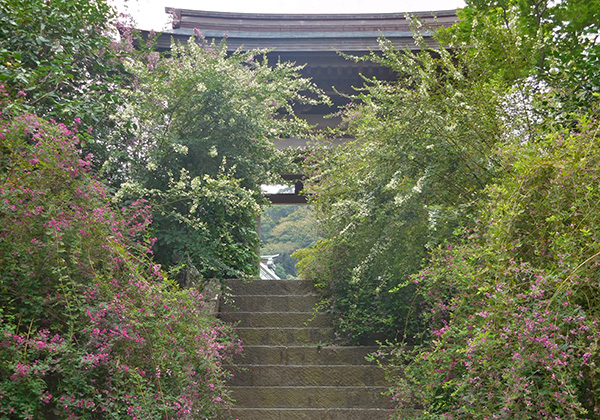
Yakushido {yah-koo-she-doh} Hall
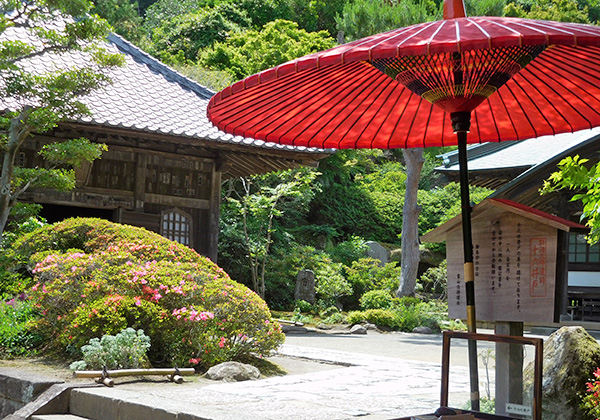
In the southwest corner of the courtyard is the 5.4-meter-square Yakushido Hall, which was brought from Jochiji in 1776 and enshrines quite a few statues. The centerpiece is the wooden statue of Yakushi Nyorai {yah-koo-she nyo-rye} or Bhaisajyaguru-vaiduryaprabha in Skt., commonly referred to as the Physician of Souls, sitting on the lotus-flower pedestal, and its two attendant statues of Nikko Bosatsu {nick-koh bo-sah-tsu} (surya-prabha in Skt.) to your right and Gakko {gak-koh} Bosatsu (candra-prabha in Skt.) to your left, forming a beautiful Yakushi Trinity. The Yakushi statue holds a head of another Yakushi Nyorai statue in its bosom, though it is not showing.
Legend has it that the founding priest often heard a baby crying sadly at night out of nowhere and he once searched the source of the weeping. It led him to a nearby cemetery, and he found a shining tombstone under which the sorrowful cry came from. He chanted sutras to ease the soul of the baby. Hearing the chant, the baby stopped crying. The next day, the priest found a head part of Yakushi Nyorai statue under the tomb. He made a statue of Yakushi Nyorai anew, and embedded the head part he found (measuring only 18 centimeters long) into the bosom of the new statue. That is what we see today at this hall. It is also called Naki {nah-key} Yakushi or Weeping Yakushi in honor of the legend.
On the both side of the trinity are statuettes of the Twelve Guardian Deities just like those attendants of theYakushi Nyorai statue at Kakuonji.
Main Hall
The main hall Ryugoden {ryu-go-den} stands in the back of the courtyard facing southeast. The building was constructed in 1925, two years after the Great Kanto Earthquake, which had destroyed the old one. However, wood-carvings of dragon at transom were made in 1812 and still reserves its original shape. Paintings on the sliding doors were drawn by one of the famous Kano school painters, who were active during the Edo Period (1603-1868) as official painters for the Shogun, warlords and emperors.
Enshrined in this hall is a statue of Shaka {sha-kah} (Sakyamuni in Skt.) Nyorai and Eleven-Headed Kan'non Bosatsu (Ekadasamukha in Skt.), for which the Temple is listed as the 26th of the Kamakura Thirty-Three Kan'non Pilgrimage. The statue of the founding priest fashioned in the 14th century is also placed in this hall.
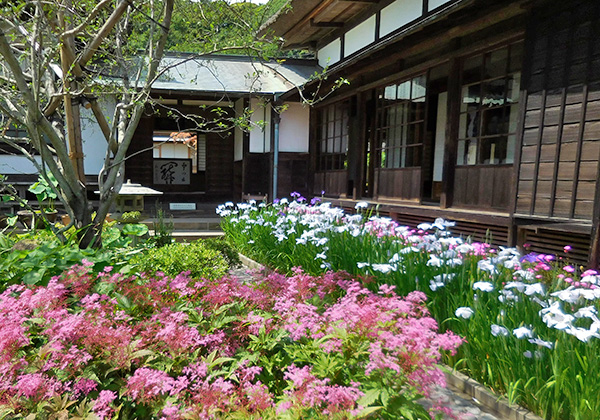
Sixteen Wells
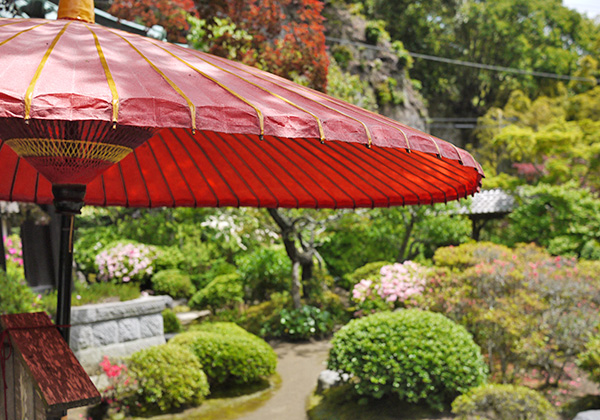
Walk along the narrow path near theYakushido Hall southward, which runs through private houses, and you will find a yagura or a cave about 100 meters ahead to your right. The cave, dug during the Kamakura Period, is roughly two-meter high and has a 16-square-meter space. On the cave floor are 16 wells, all same size with 70-centimeter diameter and 40-centimeter deep, spotted orderly. The clean water in each well has never run dry. What were those wells used for? Nobody knows for sure. The established view by the archaeologists is that they were used for burying ashes of the departed, but the Temple denies it saying each well represents a Bosatsu or Bodhisattva and the sacred water was dedicated to those Bosatsu. In a niche of the back wall is a stone statue of Kan'non Bosatsu or Avalokitesvara, under which is a small statue of Priest Kukai {koo-kye} (774-835), commonly called Kobo Daishi {ko-bo dye-she}, the founding priest of Shingon Sect Buddhism. One may wonder why the statue of Priest Kukai is enshrined here at the Zen temple. The reason is the prototype of the Temple was built as a Shingon sect way back in the early 13th century.
The cave is fenced but visitors can easily view the inside. A flashlight is provided by the courtesy of the Temple. Despite the notes saying do not throw coins into the wells, many coins are seen in the bottoms.
